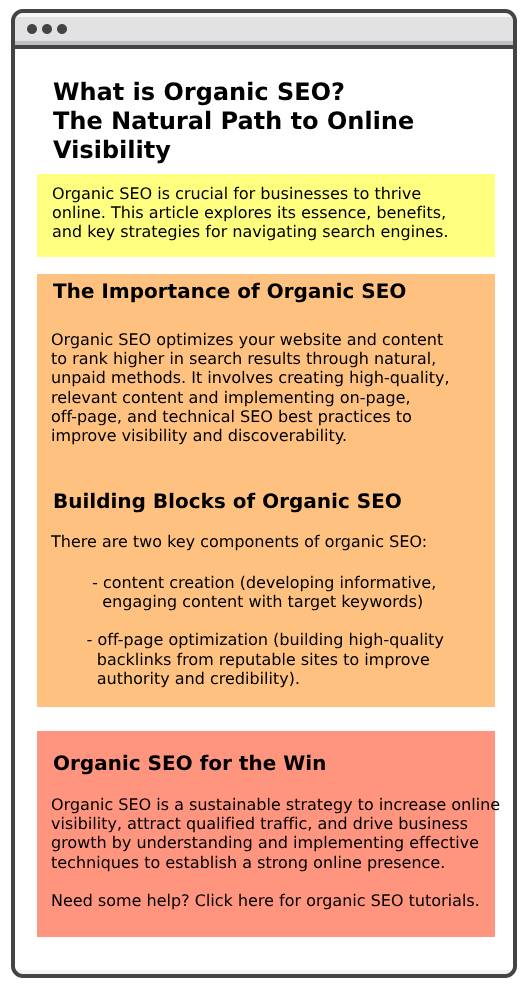Last Updated on October 3, 2024
What You Forgot You Learned at College About Writing Blog Articles
Writing is both an art and a science. Most of us don’t write unless we have to. Those four years of essays might have been enough writing for one lifetime if you attended college. However, if you’re a content marketer, SEO or Social Media specialist, copywriter, or researcher, writing is part of your daily routine.
The only difference between the writing I teach at college and the writing I teach online marketers is the goal; what is it your writing should achieve.
Whether you are writing an essay, case study, or blog article, the foundation of effective writing lies in the structure. Much like a house, a website or even a business plan. If the structure is bad, it’s doomed.

Like a college essay, the structure of an article can be described in three simple steps:
- Tell me what you are going to tell me, (yellow)
- tell me, (orange)
- and then tell me what you have told me. (red)
Let’s break down these three essential steps and see how they are used to write an engaging and helpful article.
“Your website is words. Not convinced? Remove all the words from your website. Search engines need words. Social media need words. Shoppers need words. With effective content, you can build trust and customer loyalty. And that’s worth more than just a few words.” How to Write Copy that Connects and Converts
The Three Essential Steps to Writing a Great Article
1. Tell Me What You Are Going to Tell Me
The introduction of an article sets the stage. Here’s where you grab your reader’s attention and clearly preview what’s to come.
This section should include:
- Hook: Start with a compelling sentence or question that piques interest. In other words, motivate your reader to read.
- Topic Statement: Clearly state the main topic or argument of the post. What problem is your article going to solve? What added value will it bring?
- Roadmap: Briefly outline the key points you will cover.
How to do this: If your article is about the benefits of organic SEO, your introduction might start with an important statistic about organic search traffic, state that you’ll explore why organic SEO is crucial, and list the benefits you will discuss.
2. Tell Me
The body of your article is where you delve into the details. This section should be well-organized, with each paragraph or segment covering a specific point.
The body of your article includes:
- Subheadings: Use subheadings to break up text and make it easier to scan. Each subheading should reflect a main point from your roadmap. Use your H2 and H3 headings effectively; they help search engines make sense of your article quicker.
- Clear and Concise: Keep paragraphs short and to the point. Use bullet points or numbered lists for clarity and emphasis. Search engines love lists.
- Evidence and Examples: Support your claims with data, quotes, and real-life examples. This not only strengthens your argument but also builds trust with your readers. Don’t forget to link here to both internal and external sources.
- Visuals: Incorporate images, infographics, or videos to enhance understanding and engagement. Images and videos help readers retain what they read more effectively than words alone.
Here’s an idea: Included in a section about the importance of organic SEO, you might include a case study demonstrating how a business increased its traffic through organic methods.
“Human brains retain 65% of the information presented as images, compared to 10% with text alone. This is called the Picture Superiority Effect.” susannagebauer.com/blog/content-creation
3. Tell Me What You Have Told Me
The conclusion ties everything together and reinforces your main points. It should be concise and impactful.
- Summary: Recap the main points you’ve covered without introducing new information.
- Restate the Importance: Remind readers why the topic matters and how it benefits them.
- Call to Action (CTA): Encourage readers to take a specific action, whether it’s applying the information, sharing the post, reading related articles, or subscribing to your newsletter.
Here’s an example: you might conclude by summarizing the key benefits of organic SEO, emphasizing its role in sustainable growth, and prompting readers to download an SEO checklist or contact you for a consultation.
Wrapping Up
The short, example article on organic SEO is now complete. Let’s look at the three steps again.
- (yellow) Tell me what you are going to tell me,
- (orange) tell me,
- (red) and then tell me what you have told me.
By adhering to the structure of “Tell me what you are going to tell me, tell me, and then tell me what you have told me,” you ensure that your articles are clear, cohesive, and compelling.
This approach improves readability and engagement and enhances your online marketing efforts by keeping readers on your page longer and encouraging them to explore more of your content.

Thank you for the article Image of the university lecture hall by Nikolay Georgiev from Pixabay